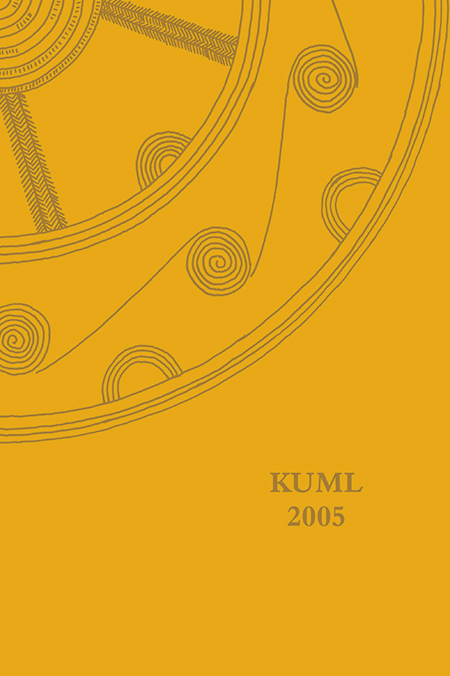De danske runestens oprindelige plads
DOI:
https://doi.org/10.7146/kuml.v54i54.97313Nøgleord:
runestenResumé
The original location of the Danish rune stonesThe rune stones have always constituted an important source concerning the Viking Age. However, from the establishment of the humanities and the empirical specialisation in the 19th century until c. 1980, the inscriptions have been the main focus. Recently, a more overall, interdisciplinary approach has been adapted in the study of the rune stones. And whereas the inscriptions are the main source for the philologists, landscape archaeology is most suited for the study of the original location of the rune stones.
This article presents aspects concerning the original location of the Danish rune stones. The material is presented using two key words, which the author finds central to the attempt to pin down what was important to that age, namely monumentality, and visibility. After that she discusses the possible relation between Danish rune stones and special sites, primarily thing sites, burial sites, and large farms. The choice of these particular categories are based on a comparison with Swedish conditions. The treatment of the question about the association with special sites may be seen as a movement from the actual source material to the mental landscape of the time.
Rather more than 200 rune and picture stones are known from Viking Age Denmark, i.e. the present Denmark and Southern Schleswig, Scania, and Halland, but exclusive Bornholm (Fig. 1). Only twelve of these are still in their assumed original location: The Ø. Løgum-stone in South Jutland (DR 15), and the Färlöv-stone in Scania, both erected during the Early Viking Age; the Glavendrup-stone (DR 209) erected on Northwest Funen during the first part of the 10th century; and the following from the time between c.950 and 1050 – the time span in which most rune stones were erected in Denmark. In Jutland, these are Bække 2 (DR 30), Randbøl (DR 40), Jelling 2 (DR 42), and Sjellebro; and in Scania: Fuglie 1 (DR 259), V. Karaby (DR 321), V. Strö 1 and 2 (DR 334 and 335), and Ö. Vemmenhög (DR 268). Add to these the Malt-stone, originally located by the Kongeå River; and the Snoldelevstone (DR 248) on East Sealand, the original locations of which are known, albeit they are now in the Sønderskov Museum and the National Museum, respectively. In the case of another 64 rune stones, the original location may be pointed out with more or less certainty and precision. These 78 rune stones, about which we have some – more or less precise - information (as opposed to a guessed location), thus make up our her source material.
To summarize, the material unambiguously points towards monumentality, visibility, and exposure having been the decisive factors to the rune stone erectors when choosing a location for their monument. The connection with large mounds, stone settings, bridges, and – as is the case with a couple of later stones – stone churches (Lund 2, DR 315 and Nr. Åsum, DR 347) is marked, as is the proximity to what is supposed to be long road stretches and communication points. Also, older monuments such as burial mounds and rock carvings seem to have constituted important links to the past, to the ancestors, and to the tradition. Both the Glavendrup- monument, Klebæk Høje with the Bække-stone 2, and the ship setting in Jelling involved older mounds within the newly established monument, just as the new Christian monument of Harald Bluetooth combined tradition and renewal in a sophisticated manner.
At the same time, it is characteristic that the rune stones – and monuments altogether – carried a message meant for the posterity, which was the whole idea behind making them. The material used for the rune stones – granite – symbolises constancy, if anything; the use of inscriptions is another way of securing against oblivion, and as a third and further emphasis of the historical character, the memory inscriptions were often followed by a memory formula (for instance Randbøl DR 40: May these runes for Thorgun live long) or a curse protecting the monument. This very preserving quality of the rune stones – and the motion towards a society with a written language – may have been the seed of the rune stones being increasingly used as a form of legal documents in connection with inheritance, boundaries, etc. Both aspects are known to a limited extent from Danish rune stones (such as the mentioned Gunderup 1), and to a larger degree within the late Norwegian and Swedish rune stone material. This function may also have been attached to the thing sites, where public and binding declarations were made.
Not surprisingly, when encircling the message of the rune stones, the preservation of the memorial for the posterity is central. That is its explicit message. Apart from this, the very act of erecting a stone and the person or persons behind this, were essential to the custom. The social act of erecting a stone in memory of a deceased reflects pride, honour, and duty. The location of the stone stresses the fact that visibility and publicity and the coupling of the past and the future were decisive factors to the or Viking Age humans who were looking for a suitable location for their rune stone.
Gunhild Øeby Nielsen
Institut for Antropologi, Arkæologi og
Lingvistik, Aarhus Universitet
Translated by Annette Lerche Trolle
Downloads
Publiceret
2005-10-20
Citation/Eksport
Nielsen, G. Øeby. (2005). De danske runestens oprindelige plads. Kuml, 54(54), 121–144. https://doi.org/10.7146/kuml.v54i54.97313
Nummer
Sektion
Artikler
Licens
Fra og med årgang 2022 er artikler udgivet i Kuml med en licens fra Creative Commons (CC BY-NC-SA 4.0).
Alle tidligere årgange af tidsskriftet er ikke udgivet med en licens fra Creative Commons.


